New Boston Historical Society
New Boston, New Hampshire
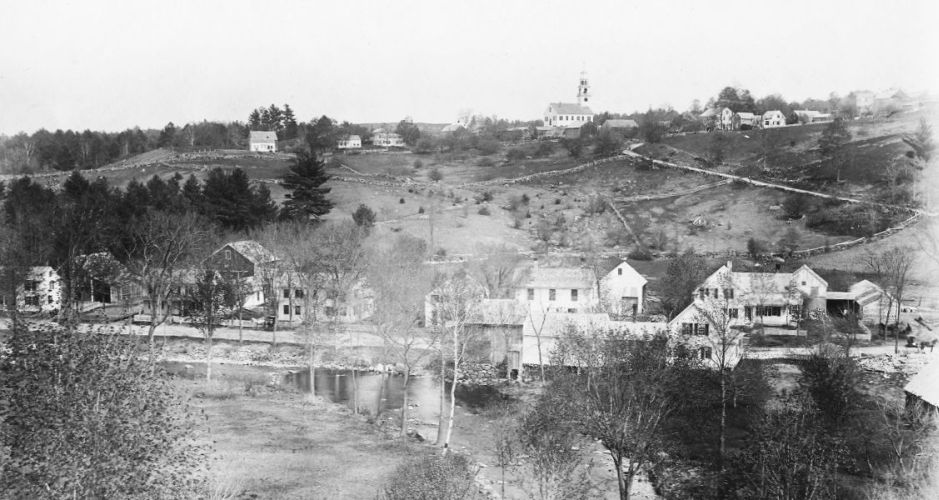
The Church on the Hill 1823-1900
Churches and Meetinghouses of New Boston
1740-1804: Building the first meetinghouses1740 - a meetinghouse is started, but it burns down
New Boston's original town charter required that within three years of the land grant, the proprietors "shall settle a learned and orthodox minister, and finish a convenient meetinghouse for the public worship of God." This was customary in colonial New England, where meetinghouses were used for town meetings and religious purposes.
New Boston's first settlement (c.1740) was near today's Gregg Mill Road and the aptly-named First Settlement Lane. Construction of a meetinghouse was started, with a steeple "ten feet square and 45 high", but the building burned before it was completed; whether by accident or by Indians is not known. A short time later, New Boston's first settlement was abandoned due to fear of Indian attack.
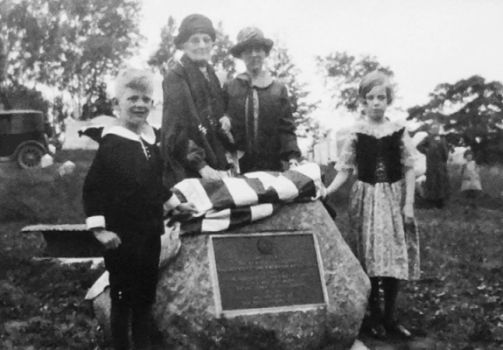 1764 - the "First Meetinghouse" is built in the Upper Village
1764 - the "First Meetinghouse" is built in the Upper VillageNew Boston was settled again in the 1750s and received a new charter in 1763. Shops and taverns were built in the Upper Village, around Cemetery Road, Bedford Road and Meetinghouse Hill Road.
Construction of a new meetinghouse began around 1764 and was completed a few years later. Its location in the New Boston cemetery is noted by a spring-fed fountain, now dry, installed by the Cemetery Trustees in 1882, and a marker (left) donated by the Daughters of the American Revolution (D.A.R.) in 1925.
It's called the First Meetinghouse because its 1740s predecessor was never completed. The First Meetinghouse was 50 feet long and 40 feet wide, with walls 22 feet high, allowing two rows of windows for a well-lit interior.
A five-foot-wide front door faced south (uphill) and there were doors facing east and west, too. There were stairs leading to a high pulpit under a sounding board along the north wall. An hourglass stood on the right hand of the pulpit; it is said that Reverend Solomon Moor preached by the hour!
There was no fireplace or stove in this 1760s meetinghouse, so people brought foot-stoves containing hot coals for warmth in wintertime. Between Sunday services, some worshippers liked to go across the street to Captain John McLaughlin's tavern. Reverend Moor complained that "they could spend two hours at McLaughlin's easier than one under his preaching," according to Cogswell's History of New Boston.
A story about the First Meetinghouse illustrates New Boston thriftiness:
The First Meetinghouse was rather plain, and in 1810 some patriotic citizens thought it might be nice to decorate the cupola with a gold eagle. They wrote to Boston to find out what it might cost, and at Town Meeting shared what they'd learned: A wooden eagle carved from hickory and gilded with gold leaf would cost five dollars. Coincidentally, at that time the one dollar coin was also called a "gold eagle".
Before the townspeople could vote on this purchase, a farmer named Joseph Dunbar rose to speak. "Gentlemen--and others, I always reckoned the voters of New Boston were big fools, and probably always would be, but if they are willing to give five honest-to-goodness gold eagles for one gilt one, they are a darned sight bigger fools than I had supposed."
To this day, if you want to see a gold eagle on a Town Hall, you have to drive to Milford NH.
1804 - a Baptist church is built on the Francestown Road
The first English-speaking people to settle New Boston were Presbyterians, but a few Baptists arrived or were converted in the late 1700s. In 1804, a one-story Baptist church 32 feet by 40 feet was built at Todd's Corner on the Francestown Road.
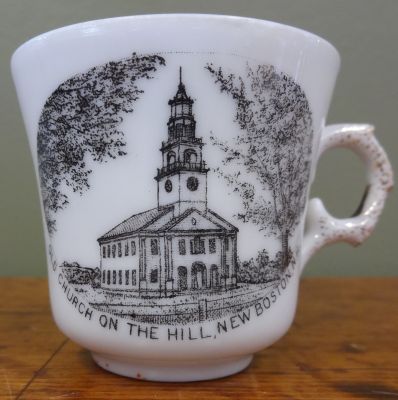
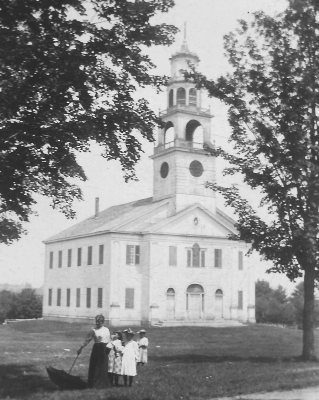
Teacup with a drawing of the 1823 Church on the Hill, and a photo of this church.
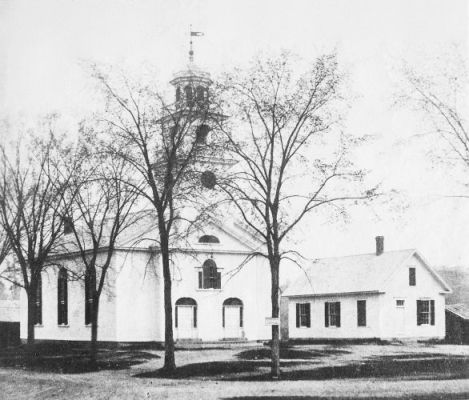
Photo of 1832 Baptist Church and 1870 Chapel in the Lower Village.
1823 - the Church on the Hill is built in the Upper Village
In the 1800s, it was decided that churches and ministers should no longer be supported by taxes. When the Presbyterians wanted to build a new church, they raised the necessary funds by selling in advance the 103 pews planned for this church. Mr. John Crombie paid $154 for a pew in a prime location; a pew in the gallery sold for only $20. (Click here to see an 1823 bill-of-sale for a medium-priced pew in the Church on the Hill.)
The Presbyterian Church on the Hill was built in the Upper Village in 1823, at the corner of Bedford Road and Molly Stark Lane. Workers were provided a barrel of West India rum, three gallons of brandy, and a half-box of lemons. As the church history tells us, "the frame was raised with a good deal of spirit but without any serious accident."
The Church on the Hill was most likely designed by Elias Carter, inspired by the Asher Benjamin handbook, as there are seven or eight other meetinghouses of similar design in New Hampshire and Massachusetts. You may see one of these meetinghouses in nearby Hancock NH.
1832 - a Baptist church is built in the Lower Village
After the red mill was built along the Piscataquog River, the center of New Boston moved down the hill to the Lower Village. In 1832 a new Baptist Church was built in the Lower Village, where the gazebo is located today. It resembled the Church on the Hill (see photos above), but was not quite as tall or grand, having only 68 pews.
1837 - a Town Hall is built in the Lower Village
When it was decided in 1837 to build a new Town Hall in the Lower Village, where today's Town Hall now stands, timbers and other material from the First Meetinghouse were brought downhill from the cemetery and recycled for the Town Hall. The New Boston Town Hall was rented by Unitarians until about 1859 and Universalists until the Civil War, as these societies had no church buildings of their own.
1874 - a Presbyterian chapel is built in the Lower Village
In 1874 a Presbyterian chapel was built in the lower village, where the New Boston Community Church now stands. This was more convenient for most parishioners than the Church on the Hill. You will understand this if you've ever driven your horse and buggy up Meetinghouse Hill Road.
1887: Fire in the Lower Village!
After May 11, 1887, only one of New Boston's meetinghouses remained: the Church on the Hill.
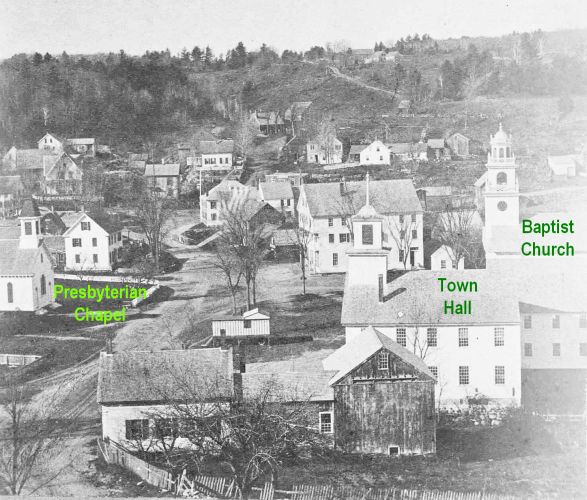
Looking west across the Lower Village before the Fire of 1887
To give the alarm during the fire, Lottie Adams and Marcy Dale ran to the Church on the Hill to ring its bell, using their combined weight to pull the rope. This was no ordinary church bell - it was a 1,415-pound Paul Revere bell, cast in 1826, and today it's the heaviest Revere bell in New Hampshire.
Fortunately, no one was killed or injured during the devastating blaze. Wet blankets were thrown on the roof of the house next to the Baptist Church, which prevented the fire from continuing down River Road.
For several months after the Fire of 1887, the Presbyterians and Baptists worshipped together in the Church on the Hill, which survived the conflagration. Later, when new Presbyterian and Baptist churches were built in the lower village, the Church on the Hill was sold at auction to Miss Lydia Atwood for use as a storehouse, and the Revere bell was moved to the new Presbyterian church, where it can be heard today.
1888-1890: Rebuilding
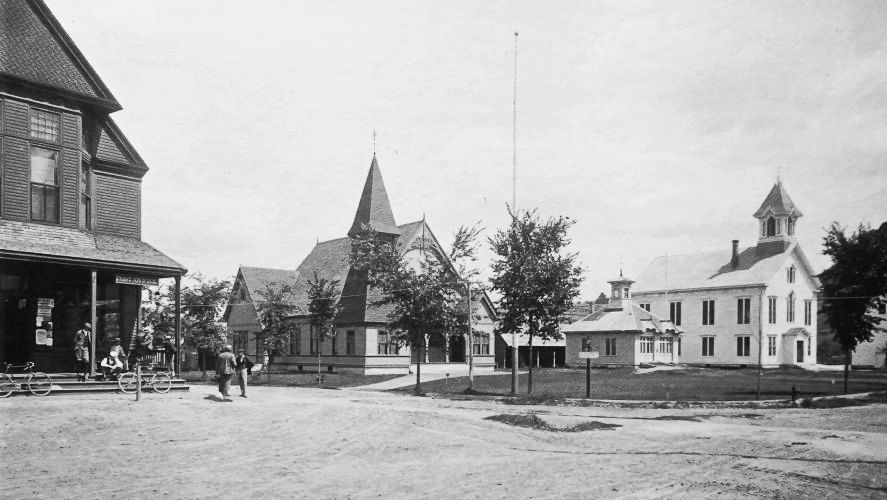
Across the street from the Engine House and Town Hall, not visible in this photo, were the Village School and the Presbyterian Church, also rebuilt after the fire. (The same man who built the new Village School and Presbyterian Church, George P. Bennett, also built the hennery and piggery for the Valley View Farm.)
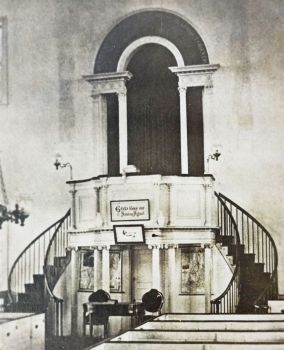
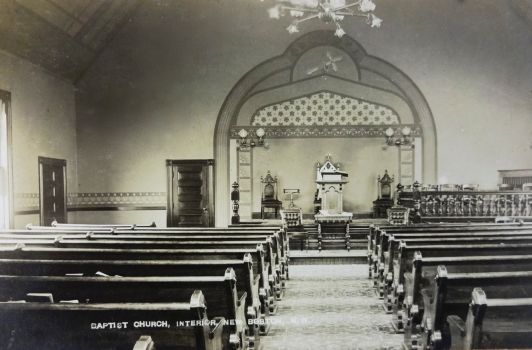
Pulpit in the 1823 Church on the Hill; interior of 1889 Baptist Church
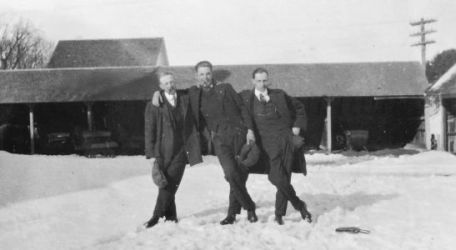 The new Baptist Church was completed in 1889.
Services in this church ceased in the 1930s due to dwindling membership, and the building was torn down in 1944.
The Baptist Society donated the land on which their church stood to New Boston for use as a town common.
The new Baptist Church was completed in 1889.
Services in this church ceased in the 1930s due to dwindling membership, and the building was torn down in 1944.
The Baptist Society donated the land on which their church stood to New Boston for use as a town common.
Walter Kirsch moved the granite foundation blocks to his sawmill on the Mont Vernon Road, and moved the horse sheds there to dry lumber. (Note the sleighs in the horse sheds behind the dapper gentlemen, in the photo to the right, when the sheds were still attached to the church.)
The church bell was shipped to a church in Clearwater FL, where Charles Read of New Boston spent his winters, or it was sold to a Baptist church in Sebring FL, depending on which story you believe. Here in New Boston, a modern Baptist Church was built by its members in 1973-74 on the Lyndeboro Road. In 2013, Marlys Johnson made a stipple drawing of the new church for the quilt that was made for New Boston's 250th anniversary.
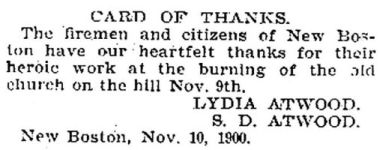 The Church on the Hill survived the Fire of 1887.
Unfortunately, its steeple was struck by lightning and caught on fire in November of 1900.
The Church on the Hill survived the Fire of 1887.
Unfortunately, its steeple was struck by lightning and caught on fire in November of 1900.
James Igo, the foreman of Whipple's Valley View Farm, wanted to cut off the burning steeple to save the rest of the church, but the fire company refused his offer. 150 firemen fought the blaze using New Boston's hand-pumped fire engine, and almost had it under control when wind fanned the flames again.
As the old meetinghouse burned to the ground, the glow from the fire was visible in Manchester, 16 miles to the east.
In 1920, the first year women had the right to vote, the Town Hall almost burned down on Election Day. This fire, extinguished by some quick action, was a result of wood slabs stored too near the furnace. Today this historic building still serves as New Boston's Town Hall.
In 1923 the Presbyterian Church purchased a pipe organ from a Methodist church in Winchester MA. The organ had 454 pipes; the largest 8 feet high and 8 inches square, made of Michigan pine, and the smallest the size of a pencil. The new organ did not have to be pumped by hand as it was equipped with an electric blower.

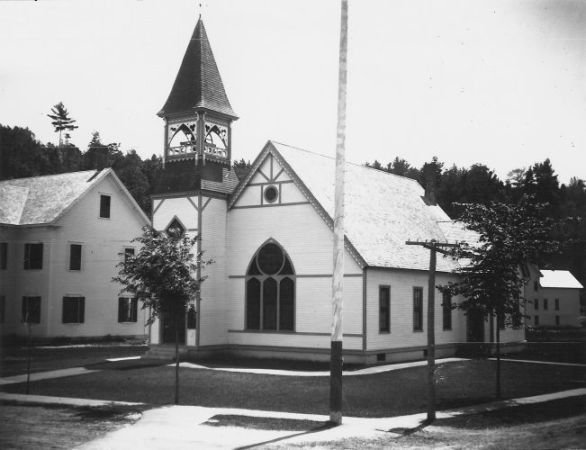
The 1888 Town Hall and the 1888 Presbyterian Church (now the Community Church) still face each other across Meetinghouse Hill Road.
The old Village School which stood next to the church has been replaced by a modern fire station.
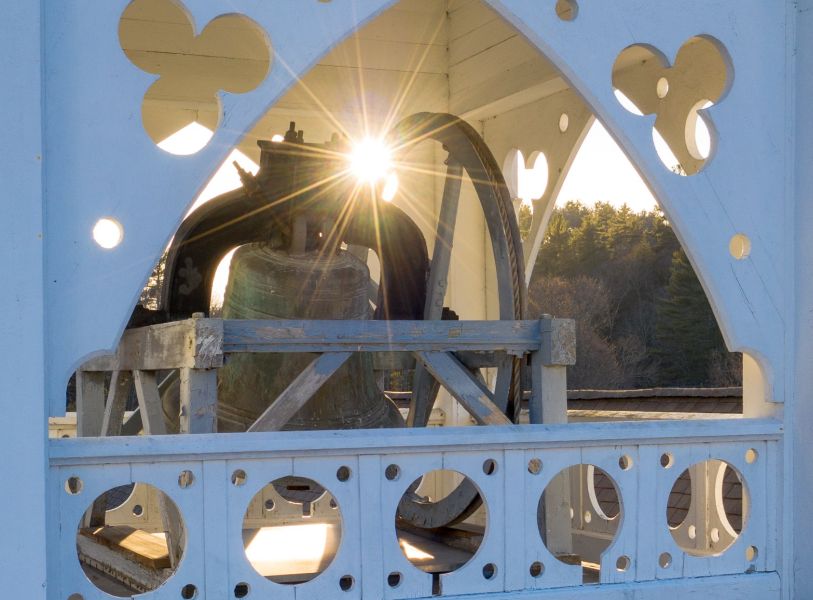
Photo of the 1826 Revere bell in the Community Church, taken in 2019 by James Murray III.
James used a Mavic 2 Pro drone.
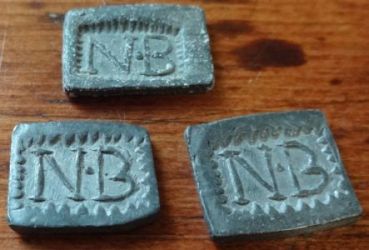 Communion Tokens
Communion Tokens
When the Historical Society prepared its "Church and Meetinghouse" special exhibit in July of 2015, we were intrigued by these communion tokens (left), each about the size of a fingerprint. These 19th-century lead tokens are marked "NB" for "New Boston", and there are two theories about how they were used:
1. Are you financially responsible? Tokens were issued to members of the congregation who had met their financial obligations to the church. In her 1988 history of New Boston's First Presbyterian Church, Rhoda Shaw Clark wrote that the tokens were "proof allowing paid-up members to take communion" and were re-collected after each service.
2. Are you morally correct? Tokens were issued by the elders of a Presbyterian Church only to parishioners whom they considered worthy to receive communion. Professor of Religious Studies Raymond Mentzer wrote: "the elders in their role as moral watchdogs distributed these entry counters to those members of the faithful whom they deemed qualified by virtue of correct belief and proper conduct."
For more information about Colonial Meetinghouses, see Paul Wainwright's informative website. The Colonial meeting houses wiki contains some of Paul's photographs, which will give you an idea of what New Boston's first meetinghouses might have looked like, outside and in.
